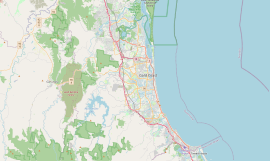Highland Park, Queensland
| Highland Park Gold Coast, Queensland | |||||||||||||||
|---|---|---|---|---|---|---|---|---|---|---|---|---|---|---|---|
 | |||||||||||||||
| Coordinates | 28°00′52″S 153°20′04″E / 28.0144°S 153.3344°E | ||||||||||||||
| Population | 6,574 (2016 census)[1] | ||||||||||||||
| • Density | 1,686/km2 (4,370/sq mi) | ||||||||||||||
| Postcode(s) | 4211 | ||||||||||||||
| Area | 3.9 km2 (1.5 sq mi) | ||||||||||||||
| Time zone | AEST (UTC+10:00) | ||||||||||||||
| Location |
| ||||||||||||||
| LGA(s) | City of Gold Coast | ||||||||||||||
| State electorate(s) | Gaven | ||||||||||||||
| Federal division(s) | Moncrieff | ||||||||||||||
| |||||||||||||||
Highland Park is a suburb in the City of Gold Coast, Queensland, Australia.[2] In the 2016 census, Highland Park had a population of 6,574 people.[1]
History[edit]
William Duncan State School opened on 27 January 1987.[3] It was officially opened on 31 October 1987 by Ivan Gibbs, the Member of the Queensland Legislative Assembly for Albert. The school is named after William Duncan, an early settler and timber-getter in the district. There had been an earlier proposal to call the school Boorajing (an Aboriginal word meaning windy place).[4]
In the 2011 census, Highland Park recorded a population of 6,561 people, 51% female and 49% male.[5] The median age of the Highland Park population was 39 years, 2 years above the national median of 37.[5] 66.3% of people living in Highland Park were born in Australia. The other top responses for country of birth were New Zealand 10.3%, England 5.7%, Philippines 0.7%, South Africa 0.7%, Japan 0.7%.[5] 86.4% of people spoke only English at home; the next most common languages were 0.9% Japanese, 0.7% Croatian, 0.6% Spanish, 0.5% German, 0.4% Italian.[5]
In the 2016 census, Highland Park had a population of 6,574 people.[1]
Education[edit]
William Duncan State School is a government primary (Prep-6) school for boys and girls at 114-136 Alexander Drive (28°00′46″S 153°20′03″E / 28.0127°S 153.3343°E).[6][7] In 2018, the school had an enrolment of 597 students with 45 teachers (41 full-time equivalent) and 30 non-teaching staff (19 full-time equivalent).[8] It includes a special education program and a positive learning centre.[6][9][10]
There is no secondary school in Highland Park. The nearest secondary school is Nerang State High School in neighbouring Nerang to the north.[11]
References[edit]
- ^ a b c Australian Bureau of Statistics (27 June 2017). "Highland Park (SSC)". 2016 Census QuickStats. Retrieved 20 October 2018.
- ^ "Highland Park – suburb in City of Gold Coast (entry 46052)". Queensland Place Names. Queensland Government. Retrieved 18 September 2020.
- ^ Queensland Family History Society (2010), Queensland schools past and present (Version 1.01 ed.), Queensland Family History Society, ISBN 978-1-921171-26-0
- ^ "History". William Duncan State School. 7 April 2020. Archived from the original on 8 October 2020. Retrieved 8 October 2020.
- ^ a b c d Australian Bureau of Statistics (31 October 2012). "Highland Park (SSC)". 2011 Census QuickStats. Retrieved 1 January 2020.
- ^ a b "State and non-state school details". Queensland Government. 9 July 2018. Archived from the original on 21 November 2018. Retrieved 21 November 2018.
- ^ "William Duncan State School". Archived from the original on 4 August 2012. Retrieved 21 November 2018.
- ^ "ACARA School Profile 2018". Australian Curriculum, Assessment and Reporting Authority. Archived from the original on 27 August 2020. Retrieved 28 January 2020.
- ^ "William Duncan SS - Special Education Program". Archived from the original on 4 August 2012. Retrieved 21 November 2018.
- ^ "Positive Learning Centres". Department of Education. Queensland Government. 6 April 2018. Archived from the original on 8 October 2020. Retrieved 8 October 2020.
- ^ "Queensland Globe". State of Queensland. Retrieved 8 October 2020.

